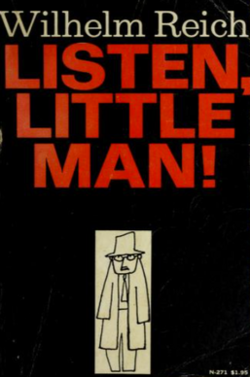In the sprawling landscape of 20th-century psychological literature, Wilhelm Reich’s Listen, Little Man! stands as a provocatively intimate whisper-sometimes a fierce admonition-aimed directly at the individual’s hidden fears and suppressed truths. Hearing the Inner Voice: A Deep Dive into Wilhelm Reich’s Listen, Little Man! invites readers to journey beyond the surface of Reich’s terse yet impassioned text, exploring the turbulent internal dialogues that shape our most vulnerable selves. This review delves into the complexities of Reich’s message, unpacking the layers of psychological insight and cultural critique that continue to challenge and resonate wiht readers decades after its first publication.
Understanding the Core Message of Listen, Little Man and Its Relevance in Modern Psychological Thought
Wilhelm Reich’s Listen, Little Man! acts as a candid mirror held up to the everyday individual, challenging them to confront the ingrained fears, anxieties, and societal pressures that dictate behavior. At its essence, the work decries the paralysis born of complacency and conformity, urging readers to reclaim personal authenticity. Reich dissects the “little man” archetype-not as a literal figure but as a symbol of inner submission to external authority and internalized oppression. This core message remains profoundly relevant today,resonating with modern psychology’s focus on self-awareness and the dismantling of cognitive distortions that prevent genuine self-expression.
Today’s psychological discourse echoes Reich’s insights through concepts such as self-actualization and emotional resilience.His warnings about the corrosive effects of repressing true feelings align closely with contemporary therapies that emphasize honesty with the self and emotional intelligence.Below is a brief comparison highlighting key themes from Reich’s message alongside their modern psychological counterparts:
| Reich’s Core Message | Modern Psychological Concept |
|---|---|
| Breaking free from societal fear and expectations | Authenticity and personal agency |
| Facing internal conflict rather than denying it | Mindfulness and emotional awareness |
| Rejecting passivity in favor of active self-exploration | self-actualization and growth mindset |
Exploring Wilhelm Reich’s Unique approach to Addressing the Human Condition Through Direct, Unfiltered Communication
Wilhelm Reich’s method hinges on piercing through societal niceties and psychological defenses,aiming to connect directly with what he termed the “inner voice” of the individual. Unlike conventional therapeutic or philosophical approaches that frequently enough obscure truth in layers of theory or politeness, Reich’s communication style is raw and unfiltered. It confronts the hidden anxieties and trivialized frustrations that many carry silently, making his message both unsettling and profoundly liberating. This form of dialog seeks not just to reveal the subconscious inner turmoil but to ignite a catalytic self-awareness that refuses complacency.
This approach challenges us to embrace discomfort and self-examination without resorting to euphemisms or deflections. Central to this process are key tenets that Reich emphasized:
- Radical honesty: Speaking truth without dilution or apology.
- Emotional boldness: Facing internal conflicts head-on, refusing to suppress or rationalize them.
- Direct engagement: Prioritizing the raw, immediate experience over abstract theorizing.
| Aspect | Conventional Communication | Reich’s Approach |
|---|---|---|
| Purpose | maintain social harmony | Expose psychological truth |
| Style | Filtered,polite | Direct,unfiltered |
| Impact | Comfort,avoidance | Awakening,discomfort |
The Role of the Inner Voice in Shaping Personal Responsibility and Social Awareness in Reich’s Narrative
Within Reich’s narrative,the inner voice emerges as a pivotal force that transcends mere self-reflection,acting as the compass that guides an individual’s moral and social compass. This voice, quiet yet persistent, demands an awakened consciousness-a call to recognize personal failings and societal obligations alike. It is indeed through this ongoing dialogue with oneself that personal responsibility begins to crystallize, urging the individual to break free from complacency and confront uncomfortable truths.Reich suggests that silencing this voice leads to internal fragmentation, while heeding it fosters an integrated identity capable of genuine empathy and accountability.
moreover, this inner whisper is not isolated but inherently linked to broader social awareness. As the individual sharpens their sensitivity to internal contradictions, they simultaneously develop a heightened perception of the collective’s struggles. The interplay between self-awareness and social conscience creates a dynamic where personal change and social engagement become inseparable. Key aspects highlighted by Reich include:
- Self-critical clarity: Embracing uncomfortable self-examination without denial or excuse.
- Empathic resonance: Allowing personal insights to inform compassion towards others’ situations.
- Active responsibility: Harnessing inner clarity to motivate tangible social action.
| Inner Voice Quality | Social Outcome |
|---|---|
| Honest Introspection | Enhanced Trustworthiness |
| Critical Awareness | Active Civic Engagement |
| Emotional Openness | Increased Empathy |
How Listen, Little Man Challenges Conventional Authority and Encourages Radical Self-Reflection
Wilhelm Reich’s Listen,Little Man! subverts traditional notions of authority by confronting the reader-positioned as the “Little Man”-with a mirror reflecting societal complacency and self-imposed limitations. Unlike conventional critiques tethered to external powers, Reich’s work forces an inward reckoning, urging a breakaway from inherited ideologies and collective conformity.Through a candid, almost confrontational tone, the text dismantles the façade of obedience and challenges individuals to question not just the authority imposed upon them but the internalized fears and anxieties that perpetuate submission.
At its core, the piece is a call to radical self-reflection, advocating a profound personal revolution where true freedom begins with embracing uncomfortable truths about oneself.This introspective journey is both isolating and empowering, as it rejects blind faith in external leaders and instead promotes:
- Self-awareness as the foundation for authentic change
- Responsibility for one’s psychological and social conditioning
- Critical examination of inherited values and norms
| Conventional Authority | Reich’s Challenge |
|---|---|
| Obedience based on external power | Personal accountability and self-rule |
| Acceptance of societal norms without question | Continuous questioning and self-examination |
| Reliance on hierarchical guidance | Empowerment through inner voice and intuition |
Diving into the Emotional Intensity and Urgency That Propels Reich’s Call to Action Throughout the Text
reich’s prose pulses with a fervent emotional charge that breaks through conventional rhetoric, compelling readers to confront their complacency head-on. The text is laced with an urgency that brooks no delay, as if every sentence is a ticking clock counting down the moments before societal decay becomes irreversible. This emotional intensity is not merely a stylistic choice but a deliberate mechanism to jolt the “Little Man” from his passivity, urging a radical awakening. His language oscillates between raw frustration and poignant lament, intricately weaving a tapestry of hope and despair that fuels his relentless call to action.
At the heart of this urgency lies a profound understanding of human psychology-Reich recognizes that emotional resonance is the spark necessary to ignite change. His appeal is multi-layered, engaging readers on both intellectual and visceral levels through elements such as:
- Direct confrontation: Challenging deeply ingrained beliefs to dismantle apathy.
- Emotive diction: Using charged words to stir discomfort and reflection.
- Repetitive calls: Reinforcing key ideas so the message embeds itself in the subconscious.
| Element | Effect on Reader | Reich’s Purpose |
|---|---|---|
| Sharp imperatives | Creates urgency and demands action | Break passivity |
| Contrasts of hope and despair | Evokes emotional complexity | Motivate through emotional engagement |
| Personalized language | Forges intimacy and accountability | Connect individual to collective struggle |
Evaluating the Literary Style and Tone That Make Reich’s Message Both Accessible and Provocative
Reich employs a literary style that is strikingly direct yet layered with metaphorical depth, crafting a voice that feels both intimate and urgent. His prose oscillates between candid admonishment and passionate exhortation, inviting readers into a dialogue that challenges complacency without alienating them. The accessibility stems from his use of everyday language, avoiding academic jargon, which allows a broad audience to engage immediately. Simultaneously, his tone carries a provocative edge-disruptive and unapologetic-that compels readers to confront their inner contradictions. this balance of simplicity and intensity is key to the enduring impact of Listen, Little Man!, as it transforms personal reflection into a revolutionary act.
Within this dynamic framework, several stylistic techniques stand out:
- Repetition: Reinforcing core ideas, creating a rhythmic insistence that echoes like an inner voice.
- Direct Address: The use of “you” implicates the reader personally, intensifying the message’s immediacy.
- contrast: Juxtaposing vulnerability with aggression, hope with despair, to reflect the complexity of human psychology.
| Stylistic Element | Effect on Reader |
|---|---|
| Repetition | Creates emphasis and a hypnotic rhythm |
| Direct Address | Fosters personal connection and accountability |
| Contrast | Highlights emotional and psychological tension |
The Impact of Reich’s Ideas on Contemporary Self-Help and Psychological Liberation Movements
Wilhelm Reich’s provocative ideas have rippled through the fabric of modern self-help and psychological liberation movements, frequently enough in subtle yet transformative ways. His emphasis on breaking free from societal conditioning and the “armor” of emotional repression resonates deeply with contemporary advocates who champion authenticity and inner freedom. Reich’s call to confront the “Little Man” within-the internalized critic and oppressor-prefigures modern cognitive-behavioral methods that urge individuals to challenge self-limiting beliefs. this legacy is evident in how many therapeutic frameworks now incorporate body awareness, emotional release, and the empowerment of the individual’s innate vitality, all hallmarks of Reich’s pioneering work.
Beyond therapy, Reich’s influence extends into community-driven movements that prioritize collective psychological liberation. These movements frequently enough share key principles with Reich’s philosophy, such as:
- Emphasizing self-awareness as a pathway to personal and societal change
- Encouraging vulnerability to dismantle internal and external oppression
- Promoting energy flow as essential to mental and emotional health
| Reich’s Principle | Modern Submission |
|---|---|
| Character Armor Concept | Emotional Resilience Training |
| Orgone Energy Theory | Mindfulness and Energy Healing |
| Inner Critic Confrontation | Self-Compassion Practices |
Such enduring relevance not only highlights Reich’s foresight but also underscores how his ideas continue to inspire those seeking to reclaim their psychological autonomy in an increasingly complex world.
critical Reflections on potential Controversies and Misinterpretations Surrounding Reich’s Work
Reich’s Listen, Little Man! inevitably provokes vigorous debate, largely due to its unapologetic tone and challenging content. Critics often misinterpret his direct address to the ”little man” as an insult, overlooking the deeper critique of societal complacency and internalized oppression that Reich aims to expose. His focus on self-awareness and personal responsibility can be misconstrued as victim-blaming rather than a call for empowerment. Moreover, Reich’s association with psychoanalysis and his later controversial theories on orgone energy tend to color readers’ perceptions, sometimes overshadowing the philosophical and psychological insights embedded within the text.
Understanding the nuances behind Reich’s message requires engaging with both his critique of external social structures and the inner psychological barriers individuals face. Below is a summary of common controversies and the potential for misinterpretation in his work:
- Tone Misread as Hostility: Directness mistaken for condescension.
- Overemphasis on Self-Responsibility: Ignoring the role of systemic influences.
- Conflation with Later Theories: Orgone energy ideas clouding initial intentions.
- Polarizing Political Views: Some view Reich’s critiques as either radical or naive.
| Aspect | Common Misinterpretation | Clarifying Insight |
|---|---|---|
| Writing Style | Insulting or aggressive | A passionate wake-up call |
| Message | Blaming the individual entirely | Balancing personal agency and societal factors |
| Legacy | discredited pseudoscience | Separating psychoanalytic roots from later experiments |
Practical Takeaways from Listen, Little Man for Cultivating Inner Strength and Authenticity in Daily Life
In Listen, Little Man!, Wilhelm Reich urges readers to confront their deepest fears and societal conditioning to unlock authentic living. One practical approach to cultivating inner strength is embracing radical self-honesty. By consistently questioning ingrained beliefs and emotional reactions, you begin dismantling the walls built by external expectations. This practice fosters resilience, allowing you to stand firm amid life’s challenges.Integrating daily moments of mindful reflection-such as journaling or silent contemplation-creates a sanctuary within where your true voice can emerge, untainted by the noise of conformity.
authenticity flourishes when you recognize and honor your basic human impulses, rather than repressing them out of fear or shame. Reich’s work highlights the importance of releasing suppressed emotions to reconnect with your core self. Consider incorporating these simple yet powerful behaviors into your routine:
- Speak your truth in small, everyday interactions.
- Notice and release tension in your body through breathing exercises.
- Set boundaries that protect your emotional energy.
- Challenge negative self-talk with affirmations or supportive dialogues.
| Challenge | Practical Step | Benefit |
|---|---|---|
| Fear of judgment | Speak honestly in trusted settings | Builds confidence |
| Emotional suppression | Practice deep breathing and introspection | Frees authentic expression |
| Conformity pressure | Set clear personal boundaries | Protects inner peace |
Suggestions for Readers Seeking to Engage More Deeply with Reich’s Philosophical and Psychological Framework
For those eager to immerse themselves in the nuances of wilhelm Reich’s philosophical and psychological theories,it’s invaluable to approach Listen,Little Man! not merely as a text but as a reflective mirror. Begin by keeping a journal to document your emotional reactions and personal insights while reading. This practice invites an active dialogue between the text and your subconscious, laying bare the “inner voice” Reich speaks of. additionally, exploring Reich’s broader body of work-especially concepts like orgone energy and character armor-provides a richer context for understanding his critique of societal conformity and psychological repression.
Engagement deepens when you integrate diverse perspectives through discussion and comparison.Joining or forming study groups can stimulate critical thinking and uncover layers often overlooked in solo reading. consider these approaches to expand your comprehension:
- Interactive Reading Sessions: Share passages aloud, emphasizing tone and emotion to capture implied nuances.
- Cross-Referencing: Contrast Reich’s ideas with contemporary psychological theories to evaluate their relevance and evolution.
- Creative Response: Use art, poetry, or even journaling to express the internal conflicts and revelations inspired by the text.
| Activity | Purpose | Suggested Frequency |
|---|---|---|
| Reflective Journaling | Track inner emotional resonance | Weekly |
| Group discussions | broaden interpretive perspectives | Bi-weekly |
| Creative expression | Manifest subconscious responses | Monthly |
Comparing Listen,Little Man with Other Influential Psychological Texts to Contextualize Its Significance
Wilhelm Reich’s listen,Little man! occupies a unique niche within the landscape of psychological literature by addressing the pervasive inner critic that many seminal texts acknowledge but seldom confront so directly. Unlike the structured psychoanalytic frameworks of Freud or Jung, Reich’s book adopts a raw, almost confrontational tone aimed at awakening self-awareness in the “little man”-a metaphor for the suppressed, complacent self.This contrasts with Viktor Frankl’s Man’s Search for Meaning, which offers a more hopeful, purpose-driven path through suffering, or Carl Rogers’ emphasis on unconditional positive regard. What sets Reich apart is his unyielding focus on how societal conditioning mutates the psyche, making Listen, Little Man! a psychological muscle flexing both personal and political dimensions.
to better grasp where Reich’s work fits among its peers, consider how key themes resonate or diverge across influential texts:
- Authority and the Individual: Reich’s critique is scathing and blunt, similar in spirit to Aldous Huxley’s The Doors of Perception but more grounded in socio-political realities.
- Inner Conflict: Echoed across Freud’s psyche model and Jung’s archetypes, yet Reich zooms in on real-world socio-economic pressures rather than mythic symbolisms.
- Empowerment vs. Victimization: Unlike Frankl’s drive to find meaning amid adversity, Reich forces readers to confront self-sabotage as a primary barrier to freedom.
| Text | Primary Focus | Tone | Unique Contribution |
|---|---|---|---|
| Listen,little Man! | Inner criticism,societal conditioning | Blunt,confrontational | Personal and political awakening |
| Man’s search for Meaning | Finding purpose amid suffering | Hopeful,philosophical | Existential resilience |
| On Becoming a Person | Self-acceptance,growth | Empathetic,nurturing | Humanistic therapy |
| The Anatomy of Melancholy | Psychological melancholy and humor | Analytical,satirical | Exploration of mood and mind |
The enduring Legacy of Wilhelm Reich as a Thought Leader Who Challenged Psychological and Social Norms
Wilhelm Reich carved out a niche in intellectual history by fearlessly confronting the rigid boundaries of orthodox psychology and societal expectations.His work transcended traditional psychoanalytical theory, venturing boldly into uncharted territories where emotion, biology, and socio-political critique converged. Reich’s insistence on listening to the authentic, frequently enough suppressed, inner voice challenged individuals to recognize the constrictive scripts imposed by culture, authority, and self-censorship. This revolutionary stance underscored the liberating potential of embracing vulnerability and self-awareness,making his legacy not merely a historical footnote but a continual call to personal and collective awakening.
In harnessing the power of this inner voice, Reich’s insights can be distilled into key themes that continue to resonate across disciplines:
- Authenticity over Conformity: Encouraging individuals to break free from societal molds and rediscover their true selves.
- Energy and Emotion as Foundations: Proposing that psychological well-being is deeply linked with the uninhibited flow of emotional energy.
- Critique of authoritarian Structures: Challenging hierarchical norms that suppress individual freedom and creativity.
- Integration of Body and mind: Highlighting the inseparability of physical and psychological experiences.
| Aspect | Reich’s Viewpoint | Modern Relevance |
|---|---|---|
| Psychological Freedom | Release of repressed emotions | Mindfulness & emotional intelligence |
| Social Norms | Critique of authoritarian control | Questioning social conformity |
| Inner Voice | Authentic self-expression | Self-awareness & empowerment |
in unraveling the layers of Wilhelm reich’s Listen, Little Man!, this exploration has traced the contours of a work that challenges its readers to confront the often silenced stirrings within. Whether you find yourself agreeing with Reich’s piercing critiques or questioning his sweeping assertions, the book undeniably provokes a reflection on the inner dialogues that shape human experience. As the final words fade,what remains is an invitation-to listen more closely to the voices inside and to reckon with the truths they may reveal,however unsettling they might be.









